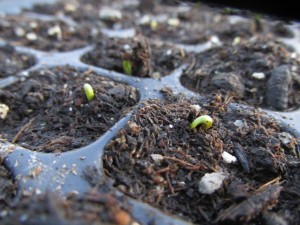Sun 14 Feb 2016
Frozen Crystals Glaze a Summer’s Bounty of Vegetables, Will 2016 Be the Year of the Snap Pea?
Posted by admin under CSA, Essay
No Comments
Greetings,
The abundance of beauty sculpted on the glass each morning is one of the true pleasures of February farmwork. It might even be a fair trade for the fierce round of poison ivy received as we renovated the small glass greenhouse at the King Farm earlier this month. Thought we would share them with you as we make a call for CSA Members to send in their registration forms.
We Invite You to Invest in Health, Make a Downpayment on Flavor…
Join Our 2016 Brix Bounty Summertime CSA.
As we start the seeds which will grow into this season’s bounty of vegetables, we ask for your support to help us reach our full potential as a neighborhood vegetable farm. Sales of our CSA shares provide the farm with the necessary capital to purchase seeds, equipment, and fertilizer at the beginning of the season. More importantly income received now helps us invest in the farm’s greatest resource – our crew members.
Full farm update below…
The fleeting tundra of February will ease its grip after the weekend and we are set to start seeding our onions Tuesday morning February 18th, in the greenhouse of course. We’ll be starting two rounds of onions this spring, one set will be guided by optimism while our second round will wait ’til early March as a hedge against another cool spring. The long range forecast is also to be considered; currently, stormy and on the cool side into early April. Along with our onions, we soon be seeding our earliest field plantings of lettuce heads, spinach, swiss chard, and kale in the greenhouse, which will be ready for transplanting around Easter.
The Weight of Potential is Buoyant, Each Seed Brings Opportunity for Health and Nourishment to Our Community and Dare We Say Pleasure
The crop plan nearly finished remains soft set, a malleable template of bounty and diversity. Jockeying hard for acreage is the crowd favorite but temperamental sugar snap pea. When spring comes early the Southcoast’s climate is a perfect season-scape for the sweetness of a garden pea. If soils remain cold and your farmer shies away from irrigation, as we do, then peas provide a challenge sometimes best left in the package. Conventional growers rely on fungicide treatment for their seeds slated for cool soils, seeds shaded unnatural colors to provide overt warning to the handler. If May or June rains are scarce and irrigation is withheld, the pods will struggle to achieve top quality. And then there are the deer, Odocoileus virginianus…
In 2015, we made a long delayed decision to invest in electrical deer fencing and the results were terrific – unfortunately installation in late June was too late to positively impact our snap peas. We set our sights on June 2016 with renewed excitement… maybe this will be the year of the pea? We are going with a “buck-shot” approach, diversifying our seed selections in hopes of bringing in a couple robust harvests. We’ll be sowing one bed of tall-vined Sugarsnaps, along with multiple beds of bush varieties. We’ll include Sugar Ann which has been a staple of pea planting for me since 2004. Additionally, we’ll bring back Cascadia, a larger podded pea which I haven’t planted in nearly 10 years but other local growers have deemed well suited for our bio-region. Finally, we’ll trial the stocky Sugar Heart which will be entirely new to Brix Bounty Farm. Cascadia and Sugar Heart are noted as 62 day varieties, nearly 10 days slower to produce than the speedy Sugar Ann. We’ve steered clear of them in previous seasons because we couldn’t reliably seed early in the wet fields on Tucker Road, and the specter of late June heat is always haunting. We are going to work to help accelerate the microclimate and conditions for early season germination by pre-warming our pea acreage with row cover and perhaps a bit of old greenhouse plastic. We learned a hard lesson in 2014 that row cover is best avoided after seeding, less we build too much humidity in the soil and invite seed rot. If are plans ring true, we aim to get a majority of our peas seeded by mid-April and if all goes well, we’ll feature a short lived bounty of peas for our CSA customers in early June.
If the peas don’t yield heavy or impress the critical metes of our taste buds, we’ll still have a dazzling array of veggies to satisfy from June through October. At this year’s Soil & Nutrition conference at the Kripalu Center I was greeted by an audience member who shared the following story, which I’ll paraphrase: “Our daughter lives in Dartmouth and a couple of years back she spoke of a nearby farm which produced amazing vegetables, vegetables her kids adored, they came from a farm on Bakerville Road… we asked her the name of the farm and she said Brix Bounty… and we said – oh yes Brix Bounty, of course we’ve heard Derek speak about soil fertility.”



Nature’s Beauty and Bounty
Soil fertility is the lens which at times threatens myopia for me as a farmer… crops not performing well? Diseases or pests blemishing your fruit? It must be the minerals, or more accurately their availability must be lacking. So fully do I place our farm’s prospects on the importance of minerals and the critical need for soil biology that we will make a silent pledge, one we’ve been making since we started the farm – we will not use any chemical fungicides, herbicides, or pesticides to produce our crops. Our focus is always to start with soil as the foundation for health, of our plants, our customers, and our environment. When speaking with other farmers, I often share my decision to invest in “full spectrum fertility” as a humble nod to the complexity of our natural systems; our efforts our guided by a notion that nature has tremendous capacity to create health, if we only provide the right conditions for complete expression.
Just one small piece of evidence our decision is well place; last week’s Reuters article linking Cuba’s avoidance of pesticides with unmatched health in their honeybee population. Our approach leads us to direct a significant portion of our resources toward improving our soil fertility each season. Through application of minerals and stewardship of biology we have set our farm’s sights on top notch nutrition and a bounty of flavor in 2016. Diversity in our intended harvest provides the seasonal notes of Summer, which we share each week with our community.
Investing Our Labor in Our Community
There are a surprising number of customers at our farmstand who don’t fully realize that every single vegetable we sell at Brix Bounty was grown and produced by us on the farm. Quite literally dozens of folks will ask each season, where do we get these veggies, misdirected by the vista of grass which sets the backdrop for our stand. Maybe we need one more sign, which states what we have always take for granted: We Grow All of Our Vegetables at Brix Bounty Farm, Each Crop is Seeded, Tended and Harvested by the Brix Bounty Crew Right Here on Bakerville Road. I reckon we might also pay a little better attention to the conditions of our South Field as the potential for showcasing our production rather than sheltering weed species. The field has been neglected at times the past two years as we labored to bring a new field into production at the farm and directed the bulk of our efforts to land out of sight and out of mind for our customers.
The reality is reflected in agriculture as a whole, most of the work which goes into producing food in America is out of sight and out of mind. On vegetable farms, this labor starts long before the summer or autumn harvests. Each season’s harvest builds on collective knowledge stewarded through generations, is made possible through prior investment in infrastructure, and for some vegetables starts with the sowing of a tiny seed well ahead of spring’s arrival…
We invite you to Invest in Your Health, Make a Downpayment on Flavor…
Join our Brix Bounty Summertime CSA
As we start the seeds which will grow into this season’s bounty of vegetables, we ask for your support to help us reach our full potential as a neighborhood vegetable farm. Sales of our CSA shares provide the farm with the necessary capital to purchase seeds, equipment, and fertilizer at the beginning of the season. More importantly income received now help us invest in the farm’s greatest resource – our crew members.
Thanks,
Derek

